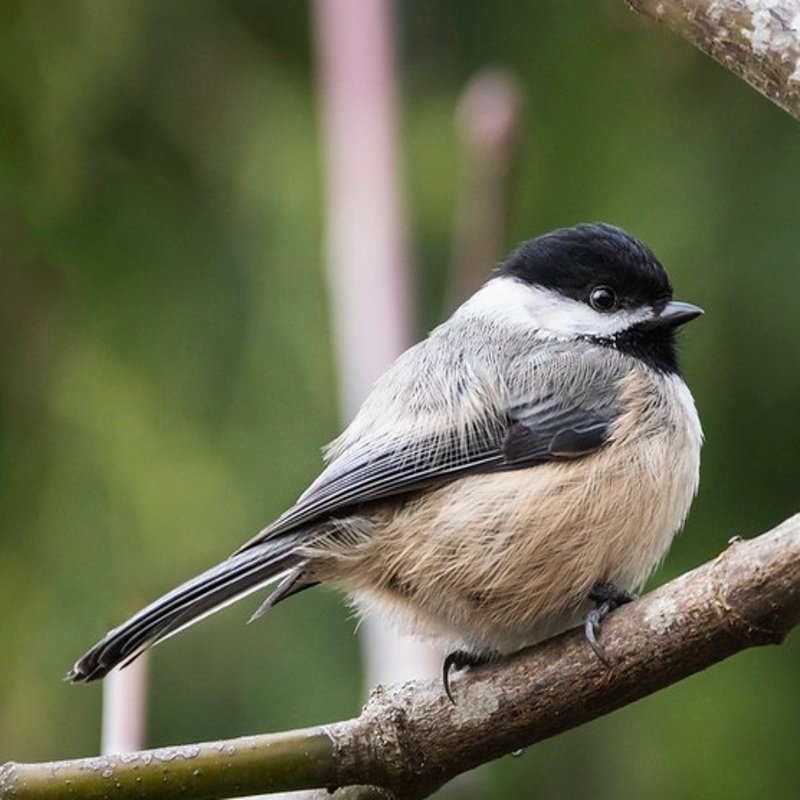Poecile atricapillus, known to be a black-capped chickadee, is a nonmigratory songbird of North America. It is a tit Paridae family bird. It is the state bird of Massachusetts and Maine, as well as New Brunswick, Canada. With its strong spatial memory and fearlessness near people, it is recognized for its ability to decrease its body temperature during chilly winter nights (sometimes feeding on the hand).
Quick Overview: Poecile Atricapillus – Black-Capped Chickadee
Body size: Around 5.5 in (14 cm) and a weight of 11 g (0.4 oz)
Main colors: Black, White, Greenish-gray
Range: Northern United States
Migratory Bird: No
Best time of the year to see in the U.S.: All Year (January – December)
Conservation Status: Least Concern
Black-capped chickadee Description
Their small plump bodies, solid black head and bib, and white cheeks make them clearly identifiable. They are little birds weighing 11 g and measuring 13.3 cm. Their wingspan in flight is 20.3 cm. Their backs and wings are dark greenish-gray with white and black stripes. Their bellies are white with rufous flanks. They have dark legs and tiny black beaks. Chickadees are gender-neutral.

Size
These birds have a length of 5.5 in (14 cm) and a weight of 11 g (0.4 oz). Their wings could range from 7.5-8.5in (19-22 cm).
Feeding
They eat both animals and vegetation (the overall consumption has been measured to be about 70 percent animal and 30 percent plant). Insects and spiders are major animals feeds. Prefer caterpillars throughout the breeding season. Chickadees consume dead deer, skunks, and fish. Chickadees consume honeysuckle, blackberries, hemlock seeds, and wax-covered berries like poison ivy and bayberry. They consume seed and suet from backyard bird feeders.
Habitat
Black-capped chickadees “hop” on trees (and infrequently on the ground). During the day, these birds are highly busy, often foraging upside-down. Black-capped chickadees form monogamous couples that mate for life. This species’ social structure has two extremes: territorial couples during the breeding season and non-breeding groups.
Behavior
To find them, look for them in cottonwood trees and willow thickets. They are usually found around forested regions. They frequent backyard feeders. Black-capped chickadees nest in holes in dead trees or stumps and are drawn to nesting sites. These birds can be seen in thick conifer woods throughout the winter.
Poecile atricapillus Scientific Classification
- Kingdom: Animalia
- Phylum: Chordata
- Subphylum: Chelicerata
- Class: Aves
- Order: Passeriformes
- Family: Paridae
- Genus: Poecile
- Species: Poecile atricapillus
Best time of the year to see
In the United States, the best time of year to see these birds is all year round, regardless of the season. This refers to any month of the year between January and December.
Distribution of the Black-capped chickadee in the USA
Throughout their range, black-capped chickadees can be found only in North America, from Alaska to the southern half of Canada and south to the upper two-thirds of the continental United States.
The Black-capped chickadee can be found in the following states in the United States – California, Colorado, Connecticut, Delaware, Hawaii, Idaho, Illinois, Indiana, Iowa, Maine, Maryland, Massachusetts, Michigan, Minnesota, Montana, Nebraska, New Hampshire, New Jersey, New Mexico, New York, North Dakota, Ohio, Oregon, Pennsylvania, Rhode Island, South Dakota, Utah, Vermont, Washington, West Virginia, Wisconsin, and Wyoming.
